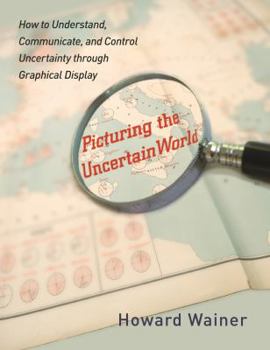Picturing the Uncertain World: How to Understand, Communicate, and Control Uncertainty Through Graphical Display
Select Format
Select Condition 
Book Overview
In his entertaining and informative book Graphic Discovery , Howard Wainer unlocked the power of graphical display to make complex problems clear. Now he's back with Picturing the Uncertain World , a book that explores how graphs can serve as maps to guide us when the information we have is ambiguous or incomplete. Using a visually diverse sampling of graphical display, from heartrending autobiographical displays of genocide in the Kovno ghetto to the "Pie Chart of Mystery" in a New Yorker cartoon, Wainer illustrates the many ways graphs can be used--and misused--as we try to make sense of an uncertain world. Picturing the Uncertain World takes readers on an extraordinary graphical adventure, revealing how the visual communication of data offers answers to vexing questions yet also highlights the measure of uncertainty in almost everything we do. Are cancer rates higher or lower in rural communities? How can you know how much money to sock away for retirement when you don't know when you'll die? And where exactly did nineteenth-century novelists get their ideas? These are some of the fascinating questions Wainer invites readers to consider. Along the way he traces the origins and development of graphical display, from William Playfair, who pioneered the use of graphs in the eighteenth century, to instances today where the public has been misled through poorly designed graphs. We live in a world full of uncertainty, yet it is within our grasp to take its measure. Read Picturing the Uncertain World and learn how.
Format:Hardcover
Language:English
ISBN:0691137595
ISBN13:9780691137599
Release Date:April 2009
Publisher:Princeton University Press
Length:264 Pages
Weight:1.53 lbs.
Dimensions:1.1" x 7.0" x 9.0"
Customer Reviews
4 ratings
Another strong offering from Wainer
Published by Thriftbooks.com User , 15 years ago
The biggest problem with Howard Wainer's books is figuring out which one to recommend first -- and now we have another strong contender. (Of course, if you haven't read them already, buy this one, but also check out _Graphic Discovery_ and some of the others.) As with his previous books, this latest offering masterfully blends the history of statistical methods and graphical displays with up-to-date examples from the headlines and policy debates of today. Chapter four alone--in which Wainer uses a simple line graph to make sense of an otherwise confusing Medicare policy--is worth the price of admission, and should be required reading for all newspaper reporters (and framers of government policy as well). Section III deals primarily with statistical puzzles rooted in the field of Educational Testing (where the author spent a good part of his life in the trenches), but I encourage you to read them even if you don't think they are relevant to your work: part of Wainer's strength is being able to use examples from all sorts of places to illustrate more general principles of statistical thinking (both clear and muddy) and graphical presentation (both illuminating and obfuscating). I teach the required graduate class in "Quantitative Reasoning and Statistical Methods" in MIT's masters course in city planning, and I look forward to my next opportunity to use this book.
Great art and wit
Published by Thriftbooks.com User , 15 years ago
This book is filled with superb graphics and insights into the study of variability and the graphical methods that can be used to summarize data. It is written in many short chapters, each of which is based on one of the authors famous papers, that can be easily digested in about 5 or 10 minutes. While a few places Wainer goes off on brief tangents about the math (that distract from the flow and are hard to follow because the lack of detail) the book flows remarkably well especially given its fractured origins. The graphics (especially the color plates) are a well rendered collection of great historical value. Graphics by Playfair, Florence Nightingale, Galton, Minard and people tracking deaths in Nazi occupied Lithuania are all talked about in detail. Beyond the art, some of the strong points of the book include: insights into what goes wrong when people do not study variability, the dissection of good and bad graphics to point out what makes a good graphic good, and a great discussion about the graphics of changes over time and how easy it is to misinterpret them. The down side of the book is that many of the graphics can be rendered fairly easily with modern analytic software (like SAS, S-Plus or R) but the author does not give links for the novice. If you want to combine this with a book that discusses how to make good scientific graphics (like the examples in this book) take a look at the masterpieces by Cleveland Visualizing Data and/or The Elements of Graphing Data.
Required Reading for Policy Wonks
Published by Thriftbooks.com User , 15 years ago
One can argue that the financial turmoil of 2008 resulted from poor decision making in the face of uncertainty. Howard Wainer is a leader in applying a more visual intuitive approach to such issues. His explanation of well meaning but statistically challenged public programs, which have wasted billions of dollars will make you want to throw stuff. This book should be required reading by people entrusted to make policy. I learned a lot from it.
Howard Wainer does it again!
Published by Thriftbooks.com User , 15 years ago
From the moment you pick this book up, you will be entertained and enlightened in roughly equal measure. Wainer's writing will be clear to readers of any background, and he elucidates his subject matter with wit and poise. His insights into the tools we use to understand our world are frequently profound, but come clothed in modest good humor. In this book Wainer does for graphics what Feynman did for physics in his "Six Easy Pieces."





